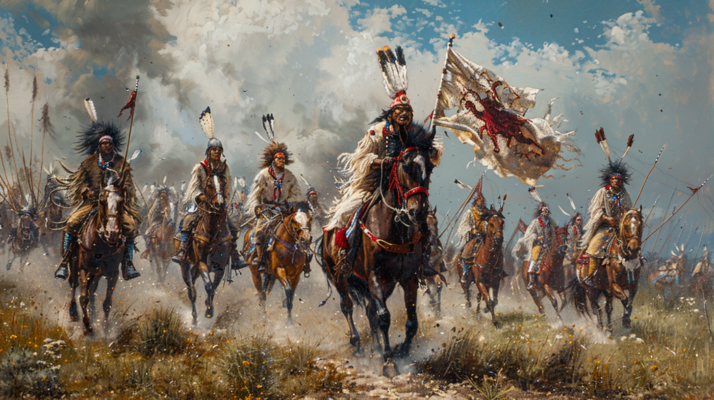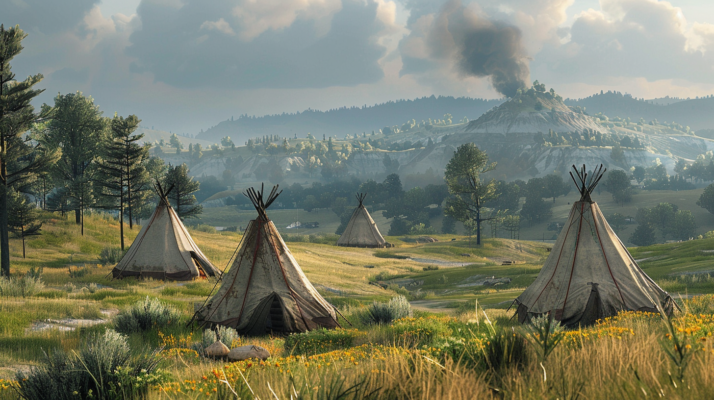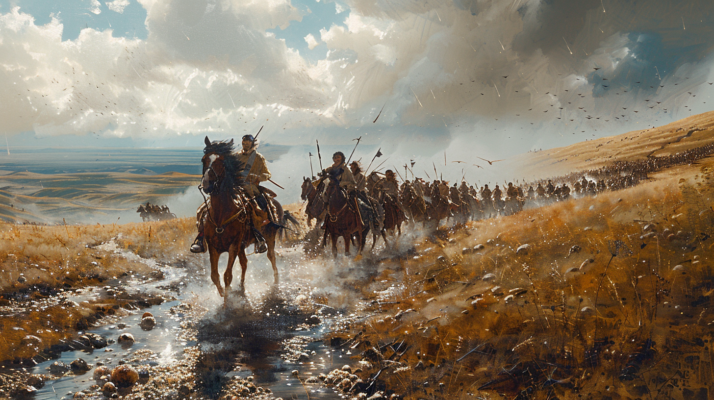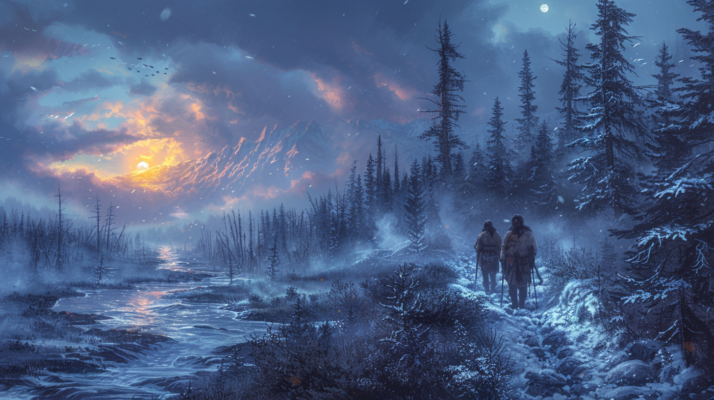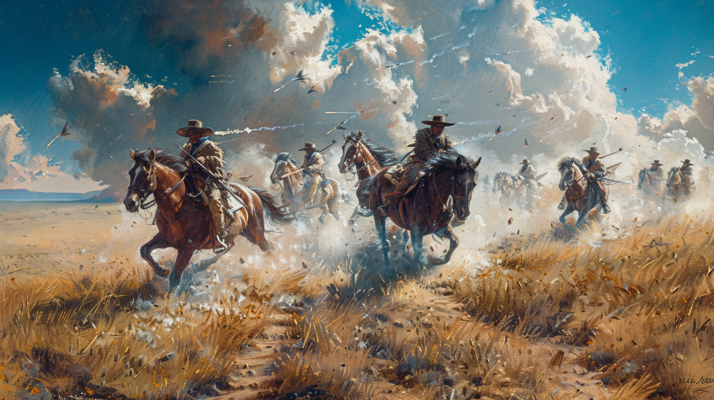In a gripping firsthand account, Young Hawk, an Iroquois scout, recounts the harrowing details of the Battle of Little Bighorn, often referred to as Custer’s Last Stand. This significant event in American history has been surrounded by mystery and debate for over a century. Now, for the first time, hear the unvarnished truth from a Native American perspective.
Young Hawk’s chilling testimony takes you onto the blood-soaked battlefield, where the fate of George Armstrong Custer and his 7th Cavalry Regiment was sealed. Get ready for a riveting and unforgettable journey into the heart of a legendary conflict. So, sit back, relax, and let’s embark on this fascinating journey together.
As you watch this video, remember to click the like button and subscribe to our channel to support this community. The army was assembled on a small knoll at the base of the hill, where they were joined by Custer’s party descending from the high butte. Considerable agitation was evident amongst the scouts, who wondered what Custer’s response would be upon learning that the Dakotas were aware of his approach.
The scouts who had descended from the hill had informed them of the six Dakotas. As Custer approached, the scouts began to gather according to their respective tribes – Iroquois, Crows, and so forth. The Iroquois grouped themselves around their older men, who addressed the younger men in accordance with the tribe’s customs.
Stabbed addressed the young men, and Custer conveyed his instructions to the scouts through Fred Gerrard. He stated, Boys, I require you to confiscate the horses from the Sioux camp. Stabbed then exhorted the Iroquois scouts to heed Custer’s instructions and endeavor to seize as many horses as possible.
Custer continued, Resolve to proceed directly to their encampment and capture their horses. Boys, you are in for a grueling day. You must steel your nerves, for you shall gain valuable experience today.
Upon reaching the ridge’s summit, the bugle sounded, signaling the unfurling of the flag, as Gerrard informed the scouts. This provoked considerable excitement, and all prepared themselves, tightening girths and lightening their loads. Another bugle blast sounded, and Custer ordered the scouts to advance.
They descended into the dry coulee, and when approximately halfway to the high ridge on the right, young Hawk espied a group of scouts at the ridge’s lower end, peering toward the solitary teepee. The scouts and his company slowed their pace as the others approached. Then, they heard Gerrard’s call from behind, The chief orders you to charge.
Strikes Two responded with a war whoop, querying, What are we doing? and wrote on. At this, we all let out war whoops, and Strikes Two reached the lone teepee first, striking it with his whip. Young Hawk followed, dismounting on the teepee’s north side, drawing a knife from his belt, and slashing the tent from top to bottom.
Inside, he beheld a scaffold, upon which lay a deceased body wrapped in a buffalo robe. At that very moment, young Hawk spotted Red Star riding beside him. All the scouts galloped around to the teepee’s north side and veered into the dry coulee beyond, where they overtook the white soldiers and rode on together, mingled in a chaotic throng.
The most skilled riders among the scouts kept pace with the soldiers, while others lagged behind. They crossed through a prairie dog village at the mouth of a dry coulee, turned sharply to the right, and young Hawk espied Red Star, Goose, Boy Chief, and Red Bear on the west side of the Little Bighorn. Anticipating his own demise and scalping by the Dakotas, young Hawk unbraided his hair, tied it forward with a bunch of loose eagle feathers, and prepared for the worst.
The battle commenced abruptly, with skirmishes erupting in front of the line, as the soldiers and scouts dismounted and held their horses in groups behind the line. The soldiers formed a line to the right, while the scouts positioned themselves to the left, near the ridge, with scattered scouts far to the left on a slant. Bob-tailed Bull stood farthest to the left, closest to the ridge.
Dakota’s skirmishers rode back and forth in front of the line. Young Hawk shifted to the right, taking his place among the scouts, who stood in the following order. Red Bear, Little Brave, Forked Horn, Red Foolish Bear, Goose, Big Belly, Crow, Strikes Enemy, Crow, and finally, Bob-tailed Bull, far out on the left flank.
Young Hawk positioned himself between Goose and Big Belly. Behind them, on the Little Big Horn, Bloody Knife appeared, approaching me directly. I gazed up at his attire and noticed the distinctive black handkerchief adorned with blue stars, a gift from Custer, and a bear’s claw with a clamshell.
Bloody Knife addressed me, declaring, Custer’s orders regarding the Sioux horses are being executed. The horses are being seized. Then, he proceeded behind the line, taking his stand beside Little Brave.
The battle intensified, and our line curved back toward the river. Many soldiers fell, and our forces began to retreat. A Dakota warrior charged courageously, closing in on the soldiers, but was felled by a bullet approximately sixteen feet from our line.
He rode a sorrel horse with a bald face and a tail tied up with a piece of red cloth. As the warrior fell, the horse continued toward us, and I claimed it. I shouted to Red Bear, offering him the captured horse, but he didn’t come to claim it.
Instead, Big Belly, a Crow Indian, approached, saying, Brother, I desire this horse. Give it to me. Big Belly, also known as Half-Yellow Face, was Young Hawk’s friend.
He took the captured Dakota horse, releasing his own inferior mount, and mounted the new steed. Meanwhile, the Dakotas had been gathering behind the ridge nearest to Bobtailed Bull. Suddenly, a dense throng of Dakotas appeared over the ridge, charging toward Bobtailed Bull in a unified mass.
Concurrently, a nearby white soldier turned to Young Hawk and exclaimed, John, you go! The Dakota onslaught pushed our line back toward the soldiers, forcing a retreat across the river, approximately two miles downstream. We traversed the flat and ascended the bluff diagonally, a grueling climb. The soldiers led the retreat, followed by the scouts, Half-Yellow Face and Strike’s enemy, the two crows, then Red Foolish Bear, Forked Horn, Goose, and Young Hawk.
As Young Hawk reached the timber, he heard Forked Horn cry, let’s dismount and make a stand. This was due to Bobtailed Bull’s precarious situation, as he was being closely pursued by the Dakotas and had fallen back near the soldiers’ fort. Young Hawk perceived this as a general signal for the scouts and leapt off his horse, followed by Goose.
They fired at the Dakotas without halting their horses, and the Dakotas turned back. Bobtailed Bull managed to cross the river at the soldiers’ fort. Young Hawk intended to fire again, but accidentally dropped his shell while loading his carbine.
The four scouts, Half-Yellow Face, Strike’s enemy, Red Foolish Bear, and Forked Horn rode into the brush and crossed the river farther downstream, less than an eighth of a mile away. Goose and Young Hawk followed, navigating the dense brush and deep water, their horses struggling to reach the opposite bank. They sought refuge in a dense grove of trees, where they found the other four scouts who had ridden ahead, unbeknownst to them.
The Dakotas surrounded them, firing through the trees as the scouts crouched on horseback. Young Hawk and Goose stood facing each other, and then Goose groaned, Cousin, I am wounded. Young Hawk’s resolve hardened, and he determined to fight to the death.
Goose revealed his wounded right hand, and Young Hawk took his cartridge belt, donning it as he stood by the horse. He helped Goose dismount, and as he did, Goose’s horse was felled by gunfire. Enraged, Young Hawk removed his coat and army blouse, ready to fight for his life.
He positioned Goose against a tree, instructing him to hold the horse, and noticed Half-Yellow Face crawling toward them. Half-Yellow Face exclaimed, My friend is being slain. He lies just at the thicket’s edge.
Young Hawk crawled with him, hands and feet, to reach the fallen Crow Scout, Strike’s enemy or White Swan, who lay on his back, arms raised. Together, they dragged him to Goose’s position, where he sat against a tree. Strike’s enemy declared, I fear not, for I am glad to be wounded.
Young Hawk confessed, The sight of my wounded comrades filled me with unease, and I dreaded witnessing their torture. Thus, I resolved to perish at the timber’s edge. Before departing, he embraced his horse’s neck, whispering, I love you.
He then crawled out, stood, and fired at the kneeling Sioux warriors, receiving a volley but emerging unscathed. Determined to try again, he crawled out to a new location, fired, and drew another volley, dropping out of sight before being hit. Nearby, he found a tree with driftwood piled against it, providing a safe haven, and discovered Forked Horn lying face down to avoid being shot.
When Forked Horn noticed that Young Hawk had drawn the Dakota’s fire twice, he scolded him, “Don’t do that again. It’s foolish to expose yourself as a target.” The Dakotas tried to set the grass on fire to smoke them out, but it was too green to ignite.
Young Hawk stayed still for a while before aiming at a Dakota on a gray horse, missing the first shot. He stood up and fired again, killing the warrior. The horse, decorated with a beautiful bridle, circled after its rider fell, likely tethered by a lariat. Young Hawk fired twice more, finally killing the horse. As it fell, he let out the Arikura yell, a traditional cry signaling the defeat of an enemy. Goose, seeing the horse fall, asked Young Hawk to retrieve the fine bridle for him.
Later, as the Sioux warriors got closer, Young Hawk took aim and brought down another warrior, following it with the death call. Dakota women arrived, urging their warriors to kill the Arikura with a woman’s yell, their cries echoing through the bushes before they left with the others.
As the attack subsided, Young Hawk observed the Dakotas moving downstream, suggesting Custer’s assault had begun at the lower fort. They saw many Dakotas crossing the river and heading north. After the shooting died down, Young Hawk stood up and saw a United States flag on the ridge above, marking the pack train’s location.
Forked Horn praised Young Hawk, “My grandson, you have proven yourself the bravest. We must now strive to reach the pack train, as Custer instructed, to avoid being mistaken for Dakotas.” Young Hawk made a makeshift flag by tying his white handkerchief to a stick. They managed to mount Strike’s Enemy on his own horse, despite his leg and hand wounds. Goose rode Red Foolish Bear’s horse, while Red Foolish Bear went on foot. Young Hawk rode ahead, holding the white flag.
As they descended the stream and climbed the slope, they saw the Dakotas returning on the east side of the ridge, swarming toward the white camp. The Custer battle had ended, and the Dakotas overwhelmed the hill where the soldiers made their final stand. The party turned back, except for Young Hawk, who held his ground, waving the white flag.
The soldiers fired over him at the enemy while the Dakotas targeted him. Near the camp, his horse was shot, but he sprang to his feet, still holding the flag, and ran into the camp. There, he encountered Peaked Face, Varnum, his chief of scouts, and found the pack train, survivors from the Little Bighorn battle, Reno and Benteen’s troops, and the officer in charge, who greeted him with relief.
The officer indicated that Bobtailed Bull, the sergeant, had fallen and his horse was in camp. Young Hawk saw Little Brave’s spotted horse, caught it, and claimed it as his own, assuming Little Brave had fallen. As the Dakotas closed in, the other scouts rejoined him, and the entire party retreated into a nearby ravine.
The Dakotas launched a fierce attack, and the gunfire was deafening on both sides, with soldiers and horses falling rapidly. The Dakotas then flanked to the right and began firing into the ravine from one end. The soldiers hastily built breastworks using crackerboxes, bacon bags, and other materials.
Young Hawk didn’t help with the breastworks but used a crackerbox as a shield while lying on the ground. The Dakotas surrounded them, firing from all sides, their lines advancing in a crouching position. The noise of gunfire was overwhelming, making it impossible to hear anything else.
The wounded were dragged to the breastworks, considered the safest spot. The intense fighting continued without pause until darkness fell. As night descended, the wounded were tended to, and the dead were laid aside.
The troops stayed vigilant throughout the night, expecting a Dakota attack. At dawn, a few shots were fired, and the battle resumed with ferocity, lasting until late afternoon. The scouts had regrouped on the side closest to the Dakota lines and the ridge.
During the first afternoon, an officer approached the scouts with a message to be delivered after dark. Forked Horn sent it, “All right.” The officer told Goose that, due to his wounds, he couldn’t participate, and each scout would carry the same message.
Later, the officer returned with a sergeant, explaining that this man would accompany them to ensure that, if all scouts were killed, the camp’s situation would be known. Goose insisted on joining, despite his wounded hand, saying he wanted to share the same fate as the others. The officer emphasized that the message was destined for the President of the United States to inform everyone of the events that had transpired.
They were allowed to ride government horses, which were faster than their own, and instructed to ride hard, ignoring anyone who might be shot by the Dakotas. If a scout fell wounded or shot, they were to leave the message paper on the ground, so soldiers could later find it and understand the situation. Forked Horn requested that the government horses’ shoes be removed, as he believed they would run better without them.
Once the messages were prepared, the two Crow scouts stayed behind, one wounded and the other to care for him. The messengers were Goose, Forked Horn, Red Foolish Bear, Young Hawk, and the White Sergeant, ready to embark on their dangerous journey. As night fell, they followed the ravine out, but the Dakotas ambushed them, forcing a hasty retreat.


